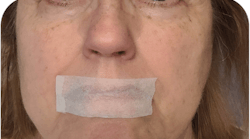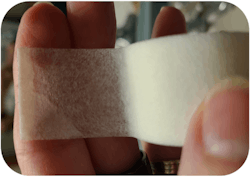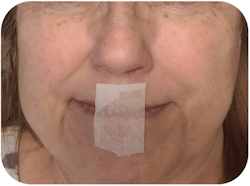Try something as you read this article—breathe only through your nose. If that seems challenging to remember, place a sticky note on your mouth to help you.
If you’re wondering why anyone would want to put tape or a sticky note over their mouth, the answer is oxygen, carbon dioxide, and nitric oxide. These are the three main gasses I work with as a Buteyko Breathing Reeducation Instructor. The three need to be in balance due to physiological forces that can best be described by a professor teaching third year physiology classes. For our purposes we’ll use the simplest forms to explain what’s going on.
The complexity of respiration
Respiration is inhalation and exhalation triggered by a chemoreceptor in the breathing center of the brain that measures carbon dioxide. When the tolerance for that gas is reached, the diaphragm is triggered to relax forcing air out of the lungs. The diaphragm then contracts bringing air into the lungs once more.
As the air rushes into the lungs, there is a hand-off happening in red blood cells (RBCs). The oxygen hops onto the RBC and the CO2 is released. In the muscles, the handoff happens again in the opposite direction.
Inside the RBCs circulating throughout the body, CO2 accumulates until the breathing center triggers the diaphragm once again. During hyperventilation, the body breathes off too much of the CO2. You may be asking, why is that a problem?1
Carbon dioxide is not just a waste gas of muscle metabolism.2 It is a functioning gas that promotes health. It helps the smooth muscle in the body, all muscle under autonomic control, relax. Smooth muscle runs the entire gastrointestinal (GI) system and encircles the cardiovascular system. Hyperventilation can trigger GI problems, even irritable bowel syndrome, and high blood pressure.3 If there’s an imbalance between carbon dioxide and oxygen they won’t release properly from the RBC.
For the most part, people are breathing too much and too hard. Mouth breathing blows off too much carbon dioxide and exposes tissues to air that are not intended to be exposed. We all learned that nose breathing warms and moisturizes the air; there’s more going on there!
The role of the nose
The nose is the organ of respiration.4 Its sensory cells translate smells to the limbic system to create all kinds of emotions and alter salivary composition to match the food being eaten. The turbinates force the air to slow down as it’s being inhaled. The turbinates are also covered in cells that make nitric oxide, a potent disinfectant that practically sterilizes the inhaled air. As a bonus, nitric oxide also helps to relax the cardiovascular system, opening up the blood vessels in the lower lung space to facilitate better transfer between oxygen and carbon dioxide.5
Preventing and treating mouth breathing
As you can see, nose breathing is pretty important. As we discover the reasons for mouth breathing, from evolutionary changes in the sizes of the sinuses to allergies and more, we can improve nose breathing by catching things early.
When we see new parents bringing their babies to the office, talk to them about nose breathing and encourage them to continue to lightly press the infant’s lips together. This will encourage proper breathing during sleep and encourage proper tongue rest posture on the palate.
In our pediatric patients, look at the palate and encourage treatments for expansion and tongue tie releases when the palate is high and narrow. If you’ve been reading this far and having your lips together, take a moment and check in how you feel. Did you already take the sticky note off? Do you feel calmer or more agitated? Does your nose itch? If you feel fine, keep going with your mouth closed as you finish up.
What if your patient is already an adult? What if their palate is high, or they have asthma, or they complain that nasal breathing is impossible? It’s not too late at all.
Patrick McKeown, author of The Oxygen Advantage and The Breathing Cure, talks about his own transformation with asthma and mouth breathing after living most of his life with an idiopathic deviated septum. He used his training with Dr. Buteyko to learn how to breathe through his crooked nose, solved his asthma with nose breathing, and has been training others how to teach it as well.
He frequently comments that after his surgery to fix the septum, no one told him to breathe through his nose. Just this comment alone from a dental health care provider to a patient can improve their lives.
There are a number of things that go wrong with facial development when mouth breathing the primary breathing method.6 Open mouth breathing deforms the temporomandibular joint. The lips may become incompetent, meaning they can’t meet. Telling little children that their lips have a partner and should always be together unless they are putting food into their mouths or talking can help improve this. In myofunctional therapy we spend a good deal of time getting the lips to rest together.
These problems are why mouth taping has been growing in popularity. If you’re still using the sticky note, you can see that it’s not a good solution to keep the mouth closed during sleep. There are many better solutions for improving nasal breathing during slumber.
Using paper tape
There are three main ways to apply paper tape. One is to use the .5- or 1-inch tape, either starting at the philtrum across the lips ending half way to the chin, or from left commissure to the right commissure. When taking the tape off the roll, always fold over the loose end about two or three millimeters. This will create a handle to remove the tape from the roll the next night as well as act as a handle to take it off the face in the morning. See Figure 2.
Some people use the 2-inch tape from commissure to commissure, using the same fold-over technique.
Another option is to use one of the tapes made specifically for sleeping. Somnifix was created by a physician who couldn’t get his CPAP machine to work because he was mouth breathing. So, he created this flexible, easy-to-remove mouth closing tape. It has a vent in the center for those who are still a little uneasy about taping all night.
For children, mouth taping should only be an option if the child can apply the tape themselves. Never tape the mouth of an infant or any child who cannot put it on and take it off by themselves. It is also imperative that the whole family be in on the game to remove the punitive stigma. This will also stop teasing by older siblings. Always test the child for at least two minutes with a sticky note to assure everyone that the child can breathe through their nose and that they can remove it.
In an effort to accommodate the child who could benefit from mouth taping but is having trouble with compliance, Buteyko instructor Patrick McKeown developed Myotape. Myotape is kinesio tape in the shape of a window frame, with the mouth as the framed picture. The child can talk but the lips are lightly encouraged to remain together. There is a size for children and adults.
There’s just one more test to do before adding mouth taping to the bedtime ritual, and that is testing the nasal valves. The Cottle Maneuver will narrow the diagnostics of nasal breathing by identifying problems with the nasal valves.7
To get an overall impression of yours or your patient’s breathing, the Buteyko Control Pause8 is also very simple, if a bit fussy. As you’ve been breathing nasally for the duration of reading this article, take a moment now to exhale and hold your breath until you get the first urge to breathe. This is not a cadence breath; rather wait until your body requests air.
For some people that’s three seconds, and for others it can be 60 or more seconds. Count the seconds from the time of the breath hold until you take the first breath, which will be easy and not noisy. That is your control pause, or body oxygen level test. The higher the better.
In summary:
- Can you breathe through your nose for an extended period?
- Does the Cottle maneuver improve breathing?
- What is your control pause or body oxygen level test score?
If you answered yes to question 1, you can probably sleep better with your mouth taped closed.
If you answered yes to question 2, you may benefit from a nasal dilator or cone.
If your control pause or body oxygen level test is under 25 it’s best if you find an instructor to help guide you to improve on that.
References
1. Bibel B. The Bohr effect: hemoglobin oxygen-carrying molecular magic. The Bumbling Biochemist. February 9, 2020. Accessed May 16, 2021. https://thebumblingbiochemist.com/365-days-of-science/the-bohr-effect-hemoglobin-oxygen-carrying-molecular-magic
2. Patel S, Miao J, Yetiskul E, Anokhin A. Physiology, carbon dioxide retention. StatPearls. Updated January 4, 2021. https://www.statpearls.com/ArticleLibrary/viewarticle/18844
3. Hyperventilation. Johns Hopkins Medicine. Accessed May 16. 2021. https://www.hopkinsmedicine.org/health/conditions-and-diseases/hyperventilation
4. Anatomy, functions, and histology of the human nose. Lecturi. Accessed May 16, 2021. https://www.lecturio.com/magazine/nose-anatomy-histology/#functions-of-the-nose
5. Moncada S, Higgs EA. The discovery of nitric oxide and its role in vascular biology. Br J Pharmacol. 2006;147 Suppl 1(Suppl 1):S193-201. doi: 10.1038/sj.bjp.0706458
6. Grippaudo C, Paolantonio EG, Antonini G, Saulle R, La Torre G, Deli R. Association between oral habits, mouth breathing and malocclusion. Acta Otorhinolaryngol Ital. 2016;36(5):386-394. doi: 10.14639/0392-100X-770
7. Tikanto J, Pirilä T. Effects of the Cottle's maneuver on the nasal valve as assessed by acoustic rhinometry. Am J Rhinol. 2007;21(4):456-9. doi: 10.2500/ajr.2007.21.3040
8. Breathing exercise 1: The control pause. Buteko Clinic. March 19, 2014. Accessed May 16, 2021. https://buteykoclinic.com/breathing-exercise-1-the-control-pause-part-i










